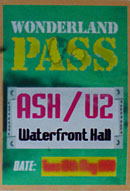 John came on from stage left and David made his appearance from the other side. They walked cautiously, past the microphone stands, the amplifiers and the effects pedals. The pair met in front of the drum riser and with some ceremony, they shook hands. David crunched down firmly, but John was also a practiced gripper. There were a few more reassuring pats, taps and exchanges and 2,000 school children roared over the awkwardness.
John came on from stage left and David made his appearance from the other side. They walked cautiously, past the microphone stands, the amplifiers and the effects pedals. The pair met in front of the drum riser and with some ceremony, they shook hands. David crunched down firmly, but John was also a practiced gripper. There were a few more reassuring pats, taps and exchanges and 2,000 school children roared over the awkwardness.
It was momentous enough but then Bono stepped in from behind, took their nearest arms and raised them over his head, like prize-fighters. Encouraged by the cheers, John Hume and David Trimble raised their spare arms so that the three of them traced out these emphatic V shapes. The international news cameras were reeling while the stills photographers grabbed the next day’s cover shot. The world was presented with the vision of two guys in their relaxed-fit shirts, dad ties and pleated suit trousers, winging it with the singer of the biggest band in the world. Bono was more recognisable with his spark-plug physique, the patrol cap and his Fidel Castro chic. It was the strangest confederation of characters. For weeks now, people had been recklessly hurling the word ‘history’ into their conversations. But here it was, May 19 1998 at the Waterfront Hall in Belfast, one of those actual moments.
It was remarkable because David Trimble and John Hume were leaders of the largest political parties of Northern Ireland: Ulster Unionist and SDLP. They represented the less extreme ends of the debate and yet they had never shaken hands in public before. Not during two years of talks with US Senator George Mitchell. Not even on the delivery of the Good Friday Agreement, April 10 or on those few weeks of fierce and dirty campaigning afterwards. Now here they were, with three days to go until the agreement referendum vote and the Yes deal finally got a shake.
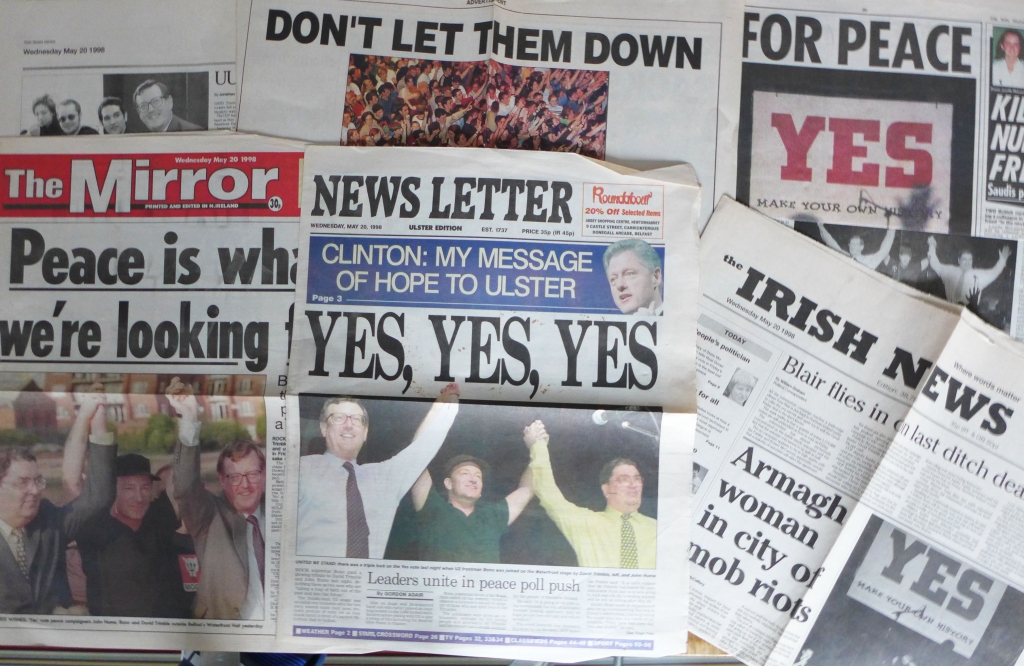 The context was a rock’n’roll show. U2 from Dublin, the band Ash from Downpatrick, plus Trimble and Hume. It was a self-conscious exchange of north and south and perceived religious persuasion and politics. If it didn’t balance, it would fall. The Corrs rang up at the last moment and offered to play but, sadly, it would have shifted the scales adversely. Meantime, there was an ongoing worry about the import of popular music, about loose minds and attitudes. This was new territory for the political parties and the risk was considerable. A flippant phrase or an incriminating press cutting could do damage.
The context was a rock’n’roll show. U2 from Dublin, the band Ash from Downpatrick, plus Trimble and Hume. It was a self-conscious exchange of north and south and perceived religious persuasion and politics. If it didn’t balance, it would fall. The Corrs rang up at the last moment and offered to play but, sadly, it would have shifted the scales adversely. Meantime, there was an ongoing worry about the import of popular music, about loose minds and attitudes. This was new territory for the political parties and the risk was considerable. A flippant phrase or an incriminating press cutting could do damage.
The Yes team was already practicing a series of rebuttals. They worried that rogue stories of Ash and some youthful drug misadventures might surface. There was the issue of the U2 song ‘Sunday Bloody Sunday’ and how that might be played out as a Republican anthem. Would Bono be perceived as a wooden horse? Earlier that day, the Ulster Unionists’ senior campaign officers had also met at their Glengall Street headquarters and they had aired extreme misgivings. But Trimble held his resolve and the show was still on.
The singer had actually been in Belfast on the night that the Good Friday agreement had been thrashed out. The Hot Press Awards took place at the BBC’s Blackstaff Studios on the evening of Thursday April 9. The big names of Irish Music had gathered for this annual event and there were masses of pop fans at the rear entrance of the Europa Hotel, screaming out for Ronan Keating. Twenty yards away and a rump of protesters had settled outside the Ulster Unionist headquarters. There were members of the UK Unionists, the Spirit of Drumcree group and the Protestant Civil Rights Group. They sang ‘The Sash’ while David Trimble discussed the peace package with his team inside. Glengall Street had been in the music event schedules as the appointed spot for the musicians’ limos, so an alternative plan was taken.
Bono marked the occasion during the Awards, making reference to another pop singer’s recent arrest in Los Angeles for a ‘lewd act’ in a public toilet in a Beverly Hills park:
‘What’s the difference between Ian Paisley and George Michael? At least George Michael will talk to anyone.’
Regardless, Sammy Wilson of the DUP had made capital of the U2 connection at an anti-agreement rally in Banbridge. In his imagined Bono setlist, he was dedicating ‘Acrobat’ to David Trimble and his ‘political gymnastics’, while ‘Helter Skelter’ would be a critique on his crashing popularity. ‘Running to Stand Still’ would be thematic of the Yes campaign while ‘Hold Me Thrill Me, Kiss Me Kill Me’ was an indicator of the Unionists, getting cosy with the Republicans, Gerry Adams and Sinn Féin.
But Bono saw a parallel to another headline-grabbing night at the National Stadium in Kingston, Jamaica. Back then it was Bob Marley who had headlined the One Love Peace Concert in front of 32,000 people. The country was riven by killings and political extremism. So, on 22 April 1978, Marley was asked to officiate. It was a masterclass in charisma and timing. He massed up the euphoria in his music, and when the rapture was at its fullest, he had called out to Michael Manley from the People’s National Party and Edward Seaga from the Jamaican Labour Party. It was an unscripted move from the singer, so the opponents were compelled, reluctantly to make their way to the stage. Bob held up their arms and thus music was able to suspend the ill feeling, to make a connection.
The Belfast moment at the Waterfront was absolutely going to be stage managed, and Bono had some input. David and John were not going to speak from the stage. It was all about the visuals and the symbolism. Their suit jackets would be too formal, so they would be set aside. They were to approach this evening like a music event. They needed to steel themselves for the blinding spotlights and the disconcerting noise and to look upwards, reaching for the people in the back row. Simple as. And then Bono would prep the audience for their appearance:
‘Two men who are making history, two men who have taken a leap of faith out of the past and into the future…’
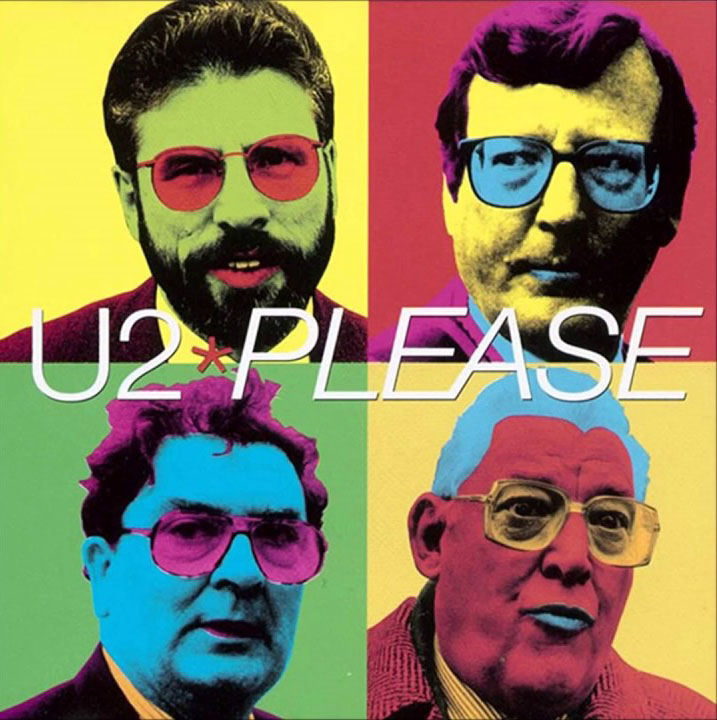 In October 1997, U2 had released ‘Please’, a song that alluded to the peace process in Northern Ireland. Or rather, the lack of any sure progress. In the lyric there was shrapnel and false prophets, flags and bloodlines. Larry Mullen played a martial snare drum, just like he did in the days of War. Months were torn off the calendar but the anxiety was unceasing. Religion was used to divide and subjugate. Bono called it ‘a mad prayer’. The lyrics asked an unknown figure to go beyond masochism and victimhood (‘so you never felt alive until you almost wasted away’) and to open up to redemptive love. Elvis Costello said it was one of his favourite songs and when Bono heard his stripped-down rendition, he declared that Elvis was showing U2 how to play it all over again.
In October 1997, U2 had released ‘Please’, a song that alluded to the peace process in Northern Ireland. Or rather, the lack of any sure progress. In the lyric there was shrapnel and false prophets, flags and bloodlines. Larry Mullen played a martial snare drum, just like he did in the days of War. Months were torn off the calendar but the anxiety was unceasing. Religion was used to divide and subjugate. Bono called it ‘a mad prayer’. The lyrics asked an unknown figure to go beyond masochism and victimhood (‘so you never felt alive until you almost wasted away’) and to open up to redemptive love. Elvis Costello said it was one of his favourite songs and when Bono heard his stripped-down rendition, he declared that Elvis was showing U2 how to play it all over again.
‘Please’ was a feature of the Pop album, a record about being lost in the supermarket, about glowing surfaces and screaming vacancy. The concept had prompted them to take a giant lemon and a neon arch on their stadium tour. The visuals often borrowed from 60s pop art and so it was not unusual to see the cover of the ‘Please’ single paying homage to Andy Warhol’s vivid screenprints. But instead of Marilyn Monroe, Elvis, Jackie Onassis and Liz Taylor, U2 provided a less alluring montage: Trimble, Hume, Adams and Paisley.
Various people had sounded out Bono about a likely referendum and the Yes campaign. The SDLP had mutual connections such as the film director Jim Sheridan and the barrister Hugh Mohan. Then again, John Hume and his wife Pat were personal friends. There was a growing expectation that Bono might do a press conference, at least. Jim Sheridan was in Belfast to support the agreement on Thursday May 14. He met Tim Attwood from the SDLP at the Wellington Park Hotel and when he learnt of the difficulties, he passed on Bono’s number and urged Tim to make an urgent call. There was no signal inside the hotel, so Tim stepped outside and rang. The response was positive.
‘I know John a little bit,’ Bono recalled a few days later. ‘We were asked to help out with the Yes campaign and I felt that I didn’t want to be part of any one community. I just feel that’s not what U2 are about really. So I said, if you can bring together John and David, we’ll do something. I was very surprised when they both came back and said that they wanted to do it, to be honest with you. We could do a gig. So Ash stepped in, they’re a boss rock band, they’re just on it. And I think that most importantly, the people need to see these two men together. Forget us, we’re up from the south and we wouldn’t dare patronise people up here, but it was still nice to throw in our tuppence worth.’
Tim Attwood then called David Kerr, Director of Communications for the Ulster Unionist Party. He was at the party’s headquarters on Glengall Street. David remembers feeling incredulous.
‘My first reaction was, “Are you serious?” We had nothing left in the tank. I just said, “Look, I think it’s a brilliant idea”. I literally went from one office to the boardroom. David Trimble was there with Ray Hayden [his media relations advisor] and a few others. I said, “This is a brilliant opportunity to reset the public focus in the final week of the referendum campaign. It’s the best opportunity we have to bring people out who are at present disconnected from politics and who may not vote, or actually worse than that, can be persuaded to vote against it on purely moral grounds”. David accepted the logic and Ray agreed.’
Tim Attwood contacted one of Belfast’s biggest music promoters, Eamonn McCann, at Wonderland. He was in the men’s department of the London department store Fortnam & Mason’s. He had a meeting in the city and had forgotten his tie, but the call took precedence. ‘Give me five minutes,’ he told Attwood. He arranged himself at a window seat, apologised to the staff and made the necessary arrangements. Very fortunately, the Waterfront Hall was free on the following Tuesday. Ash were in Rockfield Studios near Monmouth in Wales, finishing their second proper album, Nu Clear Sounds. But absolutely, they would play the gig and sure thing, U2 could borrow their gear for the night. So, they put in a swift rehearsal, packed up the van and drove north to Stranraer for the ferry over to Larne.
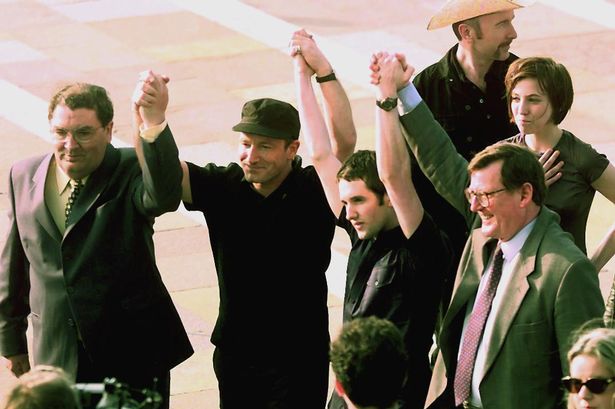 The first business of Tuesday was the meeting of the bands and the political parties on Lanyon Place by the River Lagan. U2 had flown in from London in a five-seater jet. The sun was up, a rare appearance in an otherwise dreary spring. The new arrivals walked up to the hosts. It was like High Noon. Edge wore the cowboy hat with the vented crown while his colleagues sauntered over in their Miami-Cubano casuals. And then many handshakes. The suits were hospitable and so were Ash in their skater boy attire. A journalist asked Bono how this assembly might persuade the doubters.
The first business of Tuesday was the meeting of the bands and the political parties on Lanyon Place by the River Lagan. U2 had flown in from London in a five-seater jet. The sun was up, a rare appearance in an otherwise dreary spring. The new arrivals walked up to the hosts. It was like High Noon. Edge wore the cowboy hat with the vented crown while his colleagues sauntered over in their Miami-Cubano casuals. And then many handshakes. The suits were hospitable and so were Ash in their skater boy attire. A journalist asked Bono how this assembly might persuade the doubters.
‘I dunno,’ he said. ‘We can deafen them. That’s probably the job of rock and roll. We just wanted to be part of an event that represented both sides on the community. And we’re just big fans of Ash and they’re a pretty cool band. So I hope we can highlight the good things when there’s a lot of folk out there highlighting the bad.’
John Hume had played an exhausting part in the agreement process and the years of spadework that had prepared this chance. He had been a feature in the political rough-house since the early days of the Civil Rights movement, making a case for non-violent methods while also presenting the Nationalist case. His face was a map of strain and perpetual difficulty. Now, he wanted to talk about the how Tim Wheeler and Ash were voicing a fresh aspiration.
‘It was all summed up by Tim in words I heard him speak earlier today when he said, this his generation is the generation that fully understand this problem and they want to be the last generation who has it. And the future generations will put this quarrel behind them.’
Ash had been schoolboy wonderkids in the mid-90s, taking time off from Downpatrick High for rowdy tours, delivering five top 40 hits and a number one album. Tim wrote with panache about the teenage dream and space adventures, but he was self-aware also. His father George was a District Court Judge and therefore a ‘legitimate’ target for the paramilitaries. He knew exactly what a threat amounted to. Later, he would write this up in an extraordinary song called ‘Sheltered Youth’, about a friend’s house in mourning, a body bag outside the toy store, the doctor leaving his daughter’s wedding to save lives after the Loughinisland massacre.
‘My dad worked for the court service,’ Tim says. ‘We had to check under our car for bombs every day. We had bulletproof windows in our house, which I actually decided to test one day with my friend. I was bragging to him about it and we got a catapult he said, “If I got this catapult and fired a stone at your window would it bounce off?” I was like, “Yeah, it’s bulletproof”. So, we did it and of course bulletproof glass takes the impact and it cracked. My dad had to pay to get it replaced.
‘It’s strange how when you’re a child, though, you don’t take these things so seriously. You don’t realise. The Army is around and there are all these terrible things on the news every night, but as a kid, you just get on with things and you think that’s normal.’
As he faced up to the Yes gig, he was 21. Along with Mark and Rick, Tim wrote out a press statement that concluded, ‘The ‘No’ vote offers no hope. If we don’t say Yes, what’s the alternative? We want our country to move into the future. Let’s get it together.’
The Yes gig needed a compere. Mike Edgar from Radio Ulster had been approached but the BBC had insisted on his impartiality. So, the job was offered to this freelance writer who was firstly startled by the spin-doctors and dust-busters who demanded to see the speech in advance. Truthfully, there was none. Instead, it was fitting to read the Ash statement out in full. The 2,000 school children, mainly Sixth Formers and higher education students, understood. This was an audience that appreciated the urgency and surprise on the night.
Ash played some new songs, but also batted out the reliables such as ‘Oh Yeah’, ‘Goldfinger’ and ‘Kung Fu’. There was a gap before they resumed with Edge, Bono and ‘Don’t Let Me Down’. The roughness was less important than the sense of occasion. And then there was the handshake.
Bono asked for a few moments of silence afterwards, to remember those that had suffered since 1968. He didn’t get absolute quiet. There was a bit of singing and random shouts. And then the politicians stepped away. John Hume was overwhelmed, in tears.
The U2 song ‘One’ had been partly inspired by Edge’s marital problems in 1990 but the lyric had become highly adaptable over the years. This plasticity had served as a requiem for AIDS sufferers and an anthem for a reunified Berlin. ‘One’ was about the dynamics of the band itself, it would come to reflect on Bono’s relationship with his father. At the Waterfront, it morphed into something else. It was about the various responses to living in the north of Ireland: one, but not the same. As always, the song urged the listener to feel the tensions and to roll with the paradoxes. Souls were moved. And Bono slipped in a coda of ‘Give Peace A Chance’ – his second Lennon reference of the night.
John Lennon’s spirit was definitely in the house. ‘Stand By Me’ was most famously performed by Ben E. King but Bono was singing it like John on his Rock And Roll album. To Tim Wheeler’s alarm, he was almost handed the first verse, but his mind went blank, Bono resumed and the moment passed.
Backstage, the musicians and Yes campaigners watched TV as the story was already high up the agenda on the evening news. Trimble had just gone off to another interview. Hume was spent and weary, but he knew that the night had been won. Bono went off to a private room where he met some families that had been damaged by conflict, including Sarah Conlon. Her husband Giuseppe and her son Gerard had been falsely imprisoned for the Guildford Pub Bombings. Bono had worked on the soundtrack to the Jim Sheridan film, In The Name Of The Father, which told that account. He asked Sarah what she thought about the gig. ‘It was very loud,’ she said.
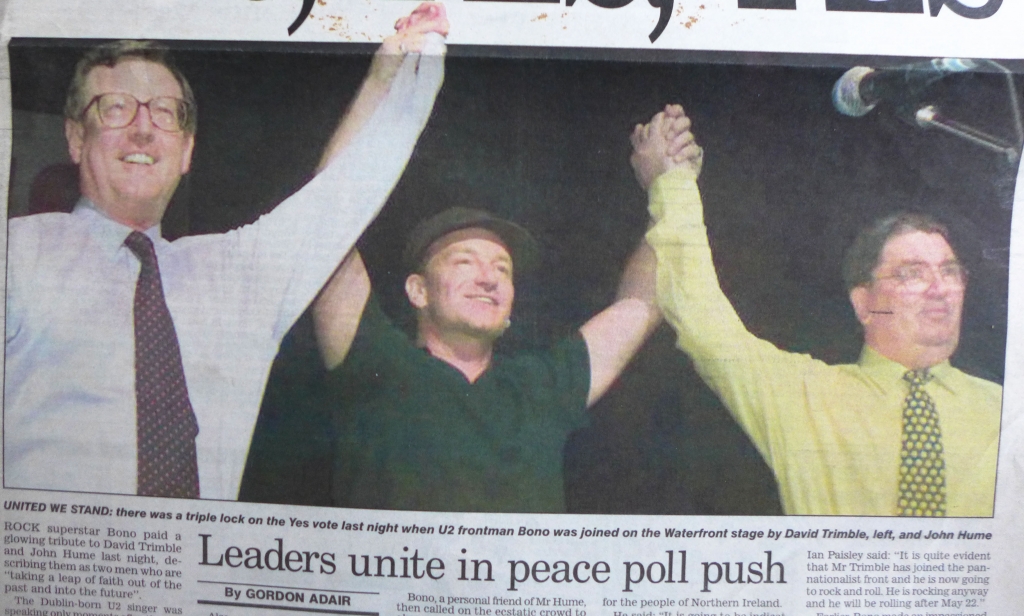 The arms-aloft image made the covers of most of the papers the following day. On the Thursday, the Ulster Unionists took out a full-page advertisement in the Belfast Telegraph, with a shot of the Waterfront audience taken from the balcony. The faces of the school children were beaming and enthralled. ‘Don’t Let Them Down’, the strapline read. The Waterfront gig had put youth onto the agenda in a very tangible way.
The arms-aloft image made the covers of most of the papers the following day. On the Thursday, the Ulster Unionists took out a full-page advertisement in the Belfast Telegraph, with a shot of the Waterfront audience taken from the balcony. The faces of the school children were beaming and enthralled. ‘Don’t Let Them Down’, the strapline read. The Waterfront gig had put youth onto the agenda in a very tangible way.
The turnout for the referendum vote was 81.1%. The Yes vote was an emphatic 71.1%. Music’s importance was the subject of some debate.
‘It was a very significant moment,’ Tim Attwood stresses. ‘It symbolised everything the Good Friday Agreement was: orange and green, Unionism and Nationalism, coming together. It changed the dynamic. The polling company suggested that between the Tony Blair pledges and the U2-Ash gig, it added six to seven per cent to the turnout. And that made the difference between Unionism saying Yes and No.’
David Kerr is sure that the event was pivotal. ‘I’m not someone who’s prone to revisionism. We had been sitting at about 67%. Had we ended up with that type of vote, we would have had a problem, straight away, with what I would call the legitimacy of the Yes vote. It would have been hard to say it was genuinely cross-community, that it had the confidence of both communities. That concert pulled 80 to 100,000 votes into the ballot boxes. It got people to vote who normally never voted. In the final analysis of that concert, it was a truly historic moment, certainly in the history of Northern Ireland. I have no doubt in my own mind that rock and roll drove the referendum vote over the magic 70% mark.’
Stuart Bailie
This is an abridged chapter from the book Trouble Songs: Music and Conflict in Northern Ireland by Stuart Bailie. Book information is here.
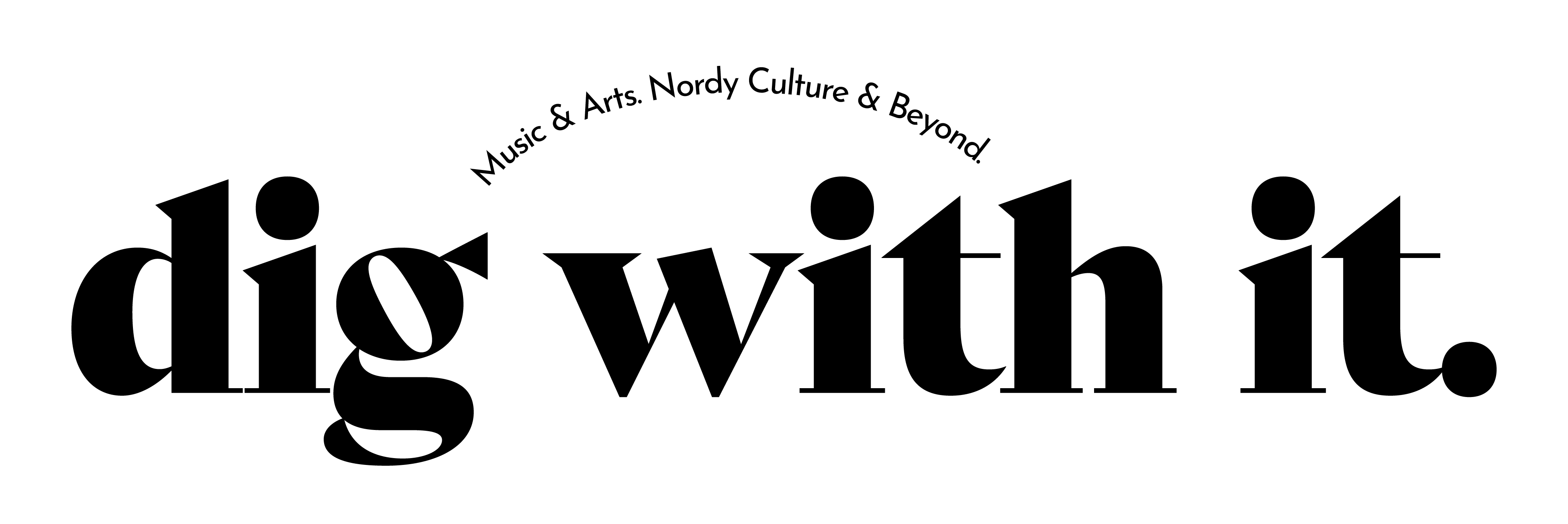





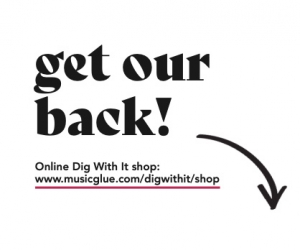
 Twitter
Twitter